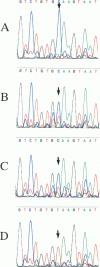Abstract
Placental aromatase deficiency has recently been shown to be due to expression of RNA transcripts encoding abnormal aromatase molecules with 29 extra amino acids. To establish whether this aromatase deficiency is a hereditary or sporadic disease, we examined the genetic defect of the aromatase gene in the family of a patient. Direct sequencing of fragments of the aromatase gene prepared by PCR revealed that the splicing donor sequence (GT) of intron 6 in controls was mutated to GC in the patient, whereas the parents showed signals of both GT and GC. Subcloning of PCR products of the parents gave two different types of clones with GT and GC sequences in this site. Furthermore, for diagnosis of this deficiency, competitive-oligo-nucleotide-priming PCR of genomic DNA was performed in the presence of both normal and mutational oligonucleotide primers labeled with two kinds of fluorescent dyes, and the products were separated by agarose gel electrophoresis and were detected fluorometrically in the gel. Genomic DNA of the patient gave a PCR product primed only by the mutational primer, whereas that of controls gave a product primed only by the normal primer. The PCR products of the parents were primed by both primers. The results obtained by this fluorometric method were also confirmed by differential hybridizations with specific oligonucleotide probes. Thus these findings indicate that this deficiency is an autosomal hereditary disease and that the patient is a homozygote, while the parents are heterozygotes, for this mutation.
Full text
PDF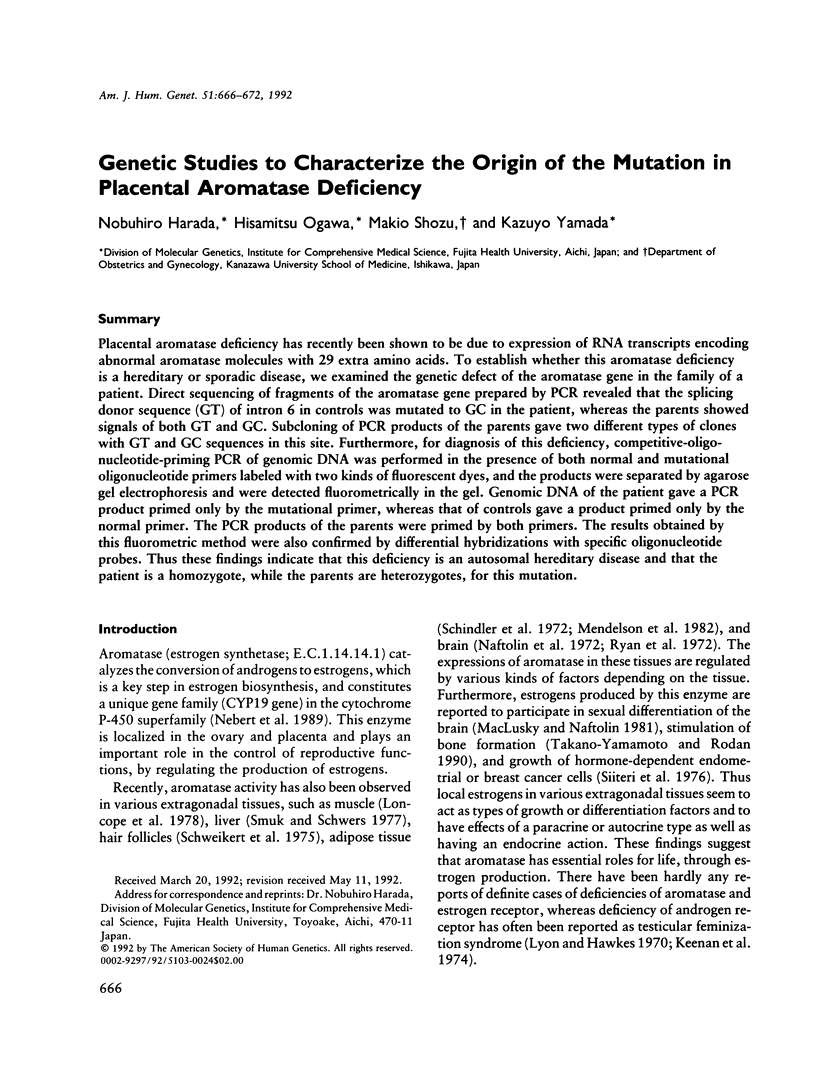

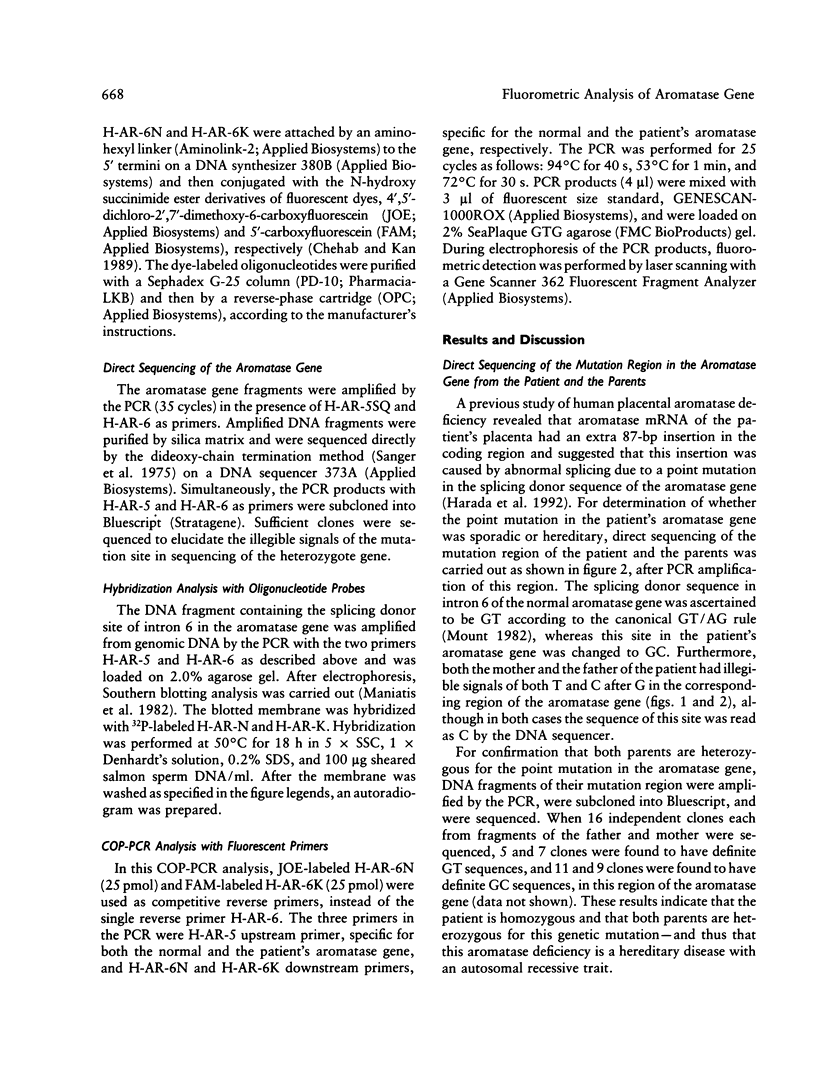
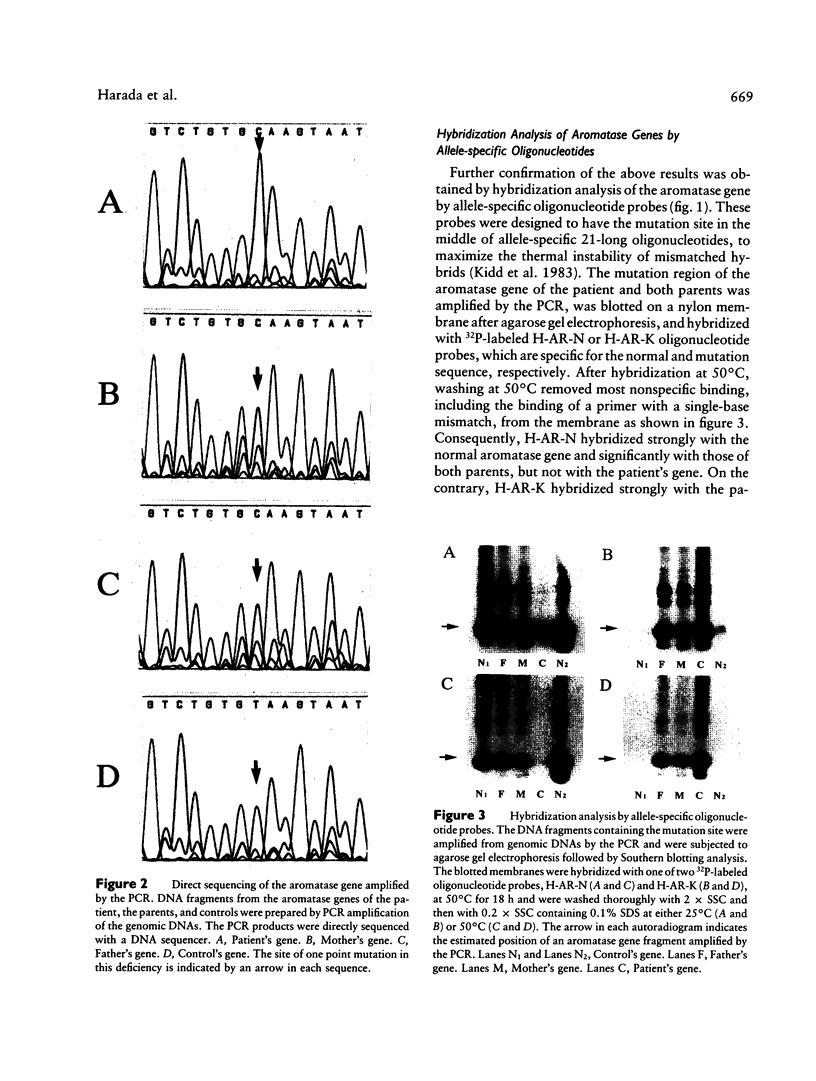

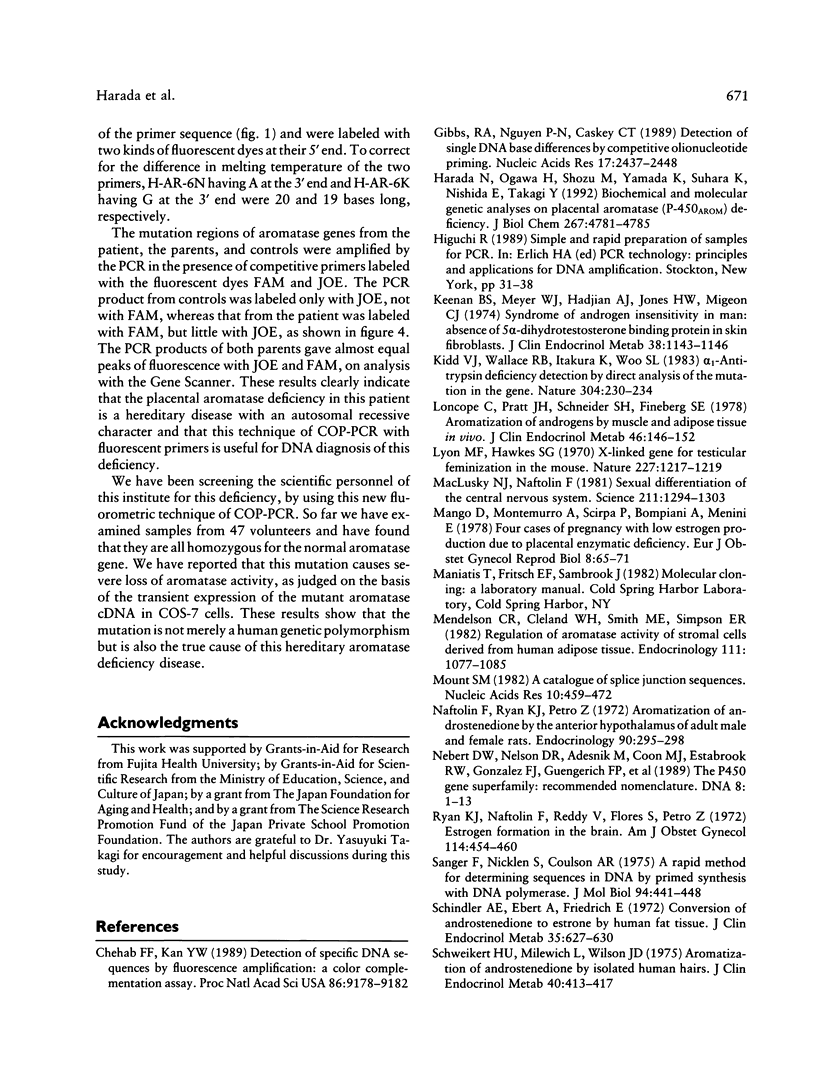

Images in this article
Selected References
These references are in PubMed. This may not be the complete list of references from this article.
- Chehab F. F., Kan Y. W. Detection of specific DNA sequences by fluorescence amplification: a color complementation assay. Proc Natl Acad Sci U S A. 1989 Dec;86(23):9178–9182. doi: 10.1073/pnas.86.23.9178. [DOI] [PMC free article] [PubMed] [Google Scholar]
- Gibbs R. A., Nguyen P. N., Caskey C. T. Detection of single DNA base differences by competitive oligonucleotide priming. Nucleic Acids Res. 1989 Apr 11;17(7):2437–2448. doi: 10.1093/nar/17.7.2437. [DOI] [PMC free article] [PubMed] [Google Scholar]
- Harada N., Ogawa H., Shozu M., Yamada K., Suhara K., Nishida E., Takagi Y. Biochemical and molecular genetic analyses on placental aromatase (P-450AROM) deficiency. J Biol Chem. 1992 Mar 5;267(7):4781–4785. [PubMed] [Google Scholar]
- Keenan B. S., Meyer W. J., 3rd, Hadjian A. J., Jones H. W., Migeon C. J. Syndrome of androgen insensitivity in man: absence of 5 alpha-dihydrotestosterone binding protein in skin fibroblasts. J Clin Endocrinol Metab. 1974 Jun;38(6):1143–1146. doi: 10.1210/jcem-38-6-1143. [DOI] [PubMed] [Google Scholar]
- Kidd V. J., Wallace R. B., Itakura K., Woo S. L. alpha 1-antitrypsin deficiency detection by direct analysis of the mutation in the gene. Nature. 1983 Jul 21;304(5923):230–234. doi: 10.1038/304230a0. [DOI] [PubMed] [Google Scholar]
- Longcope C., Pratt J. H., Schneider S. H., Fineberg S. E. Aromatization of androgens by muscle and adipose tissue in vivo. J Clin Endocrinol Metab. 1978 Jan;46(1):146–152. doi: 10.1210/jcem-46-1-146. [DOI] [PubMed] [Google Scholar]
- Lyon M. F., Hawkes S. G. X-linked gene for testicular feminization in the mouse. Nature. 1970 Sep 19;227(5264):1217–1219. doi: 10.1038/2271217a0. [DOI] [PubMed] [Google Scholar]
- MacLusky N. J., Naftolin F. Sexual differentiation of the central nervous system. Science. 1981 Mar 20;211(4488):1294–1302. doi: 10.1126/science.6163211. [DOI] [PubMed] [Google Scholar]
- Mango D., Montemurro A., Scirpa P., Bompiani A., Menini E. Four cases of pregnancy with low estrogen production due to placental enzymatic deficiency. Eur J Obstet Gynecol Reprod Biol. 1978 Apr;8(2):65–71. doi: 10.1016/0028-2243(78)90129-6. [DOI] [PubMed] [Google Scholar]
- Mendelson C. R., Cleland W. H., Smith M. E., Simpson E. R. Regulation of aromatase activity of stromal cells derived from human adipose tissue. Endocrinology. 1982 Oct;111(4):1077–1085. doi: 10.1210/endo-111-4-1077. [DOI] [PubMed] [Google Scholar]
- Mount S. M. A catalogue of splice junction sequences. Nucleic Acids Res. 1982 Jan 22;10(2):459–472. doi: 10.1093/nar/10.2.459. [DOI] [PMC free article] [PubMed] [Google Scholar]
- Naftolin F., Ryan K. J., Petro Z. Aromatization of androstenedione by the anterior hypothalamus of adult male and female rats. Endocrinology. 1972 Jan;90(1):295–298. doi: 10.1210/endo-90-1-295. [DOI] [PubMed] [Google Scholar]
- Nebert D. W., Nelson D. R., Adesnik M., Coon M. J., Estabrook R. W., Gonzalez F. J., Guengerich F. P., Gunsalus I. C., Johnson E. F., Kemper B. The P450 superfamily: updated listing of all genes and recommended nomenclature for the chromosomal loci. DNA. 1989 Jan-Feb;8(1):1–13. doi: 10.1089/dna.1.1989.8.1. [DOI] [PubMed] [Google Scholar]
- Ryan K. J., Naftolin F., Reddy V., Flores F., Petro Z. Estrogen formation in the brain. Am J Obstet Gynecol. 1972 Oct 15;114(4):454–460. doi: 10.1016/0002-9378(72)90204-9. [DOI] [PubMed] [Google Scholar]
- Sanger F., Coulson A. R. A rapid method for determining sequences in DNA by primed synthesis with DNA polymerase. J Mol Biol. 1975 May 25;94(3):441–448. doi: 10.1016/0022-2836(75)90213-2. [DOI] [PubMed] [Google Scholar]
- Schindler A. E., Ebert A., Friedrich E. Conversion of androstenedione to estrone by human tissue. J Clin Endocrinol Metab. 1972 Oct;35(4):627–630. doi: 10.1210/jcem-35-4-627. [DOI] [PubMed] [Google Scholar]
- Schweikert H. U., Milewich L., Wilson J. D. Aromatization of androstenedione by isolated human hairs. J Clin Endocrinol Metab. 1975 Mar;40(3):413–417. doi: 10.1210/jcem-40-3-413. [DOI] [PubMed] [Google Scholar]
- Shozu M., Akasofu K., Harada T., Kubota Y. A new cause of female pseudohermaphroditism: placental aromatase deficiency. J Clin Endocrinol Metab. 1991 Mar;72(3):560–566. doi: 10.1210/jcem-72-3-560. [DOI] [PubMed] [Google Scholar]
- Siiteri P. K., Williams J. E., Takaki N. K. Steroid abnormalities in endometrial and breast carcinoma: a unifying hypothesis. J Steroid Biochem. 1976 Nov-Dec;7(11-12):897–903. doi: 10.1016/0022-4731(76)90008-x. [DOI] [PubMed] [Google Scholar]
- Smuk M., Schwers J. Aromatization of androstenedione by human adult liver in vitro. J Clin Endocrinol Metab. 1977 Nov;45(5):1009–1012. doi: 10.1210/jcem-45-5-1009. [DOI] [PubMed] [Google Scholar]
- Takano-Yamamoto T., Rodan G. A. Direct effects of 17 beta-estradiol on trabecular bone in ovariectomized rats. Proc Natl Acad Sci U S A. 1990 Mar;87(6):2172–2176. doi: 10.1073/pnas.87.6.2172. [DOI] [PMC free article] [PubMed] [Google Scholar]



